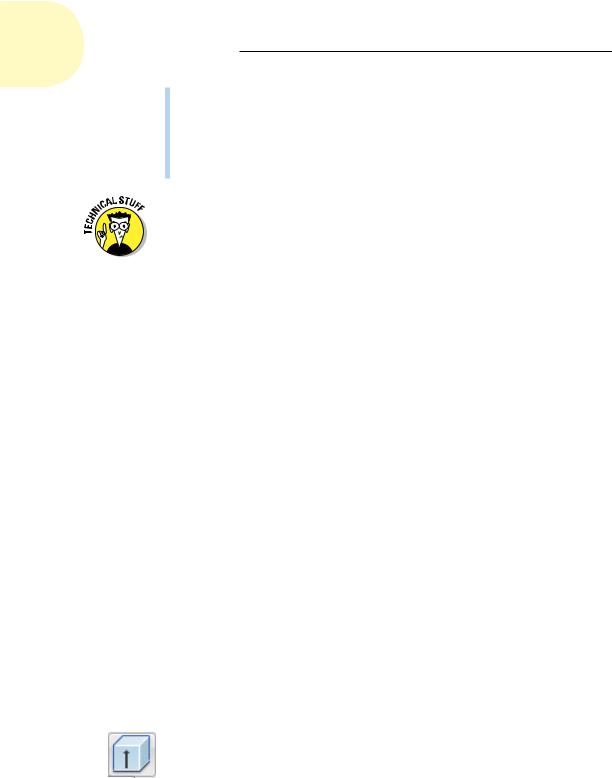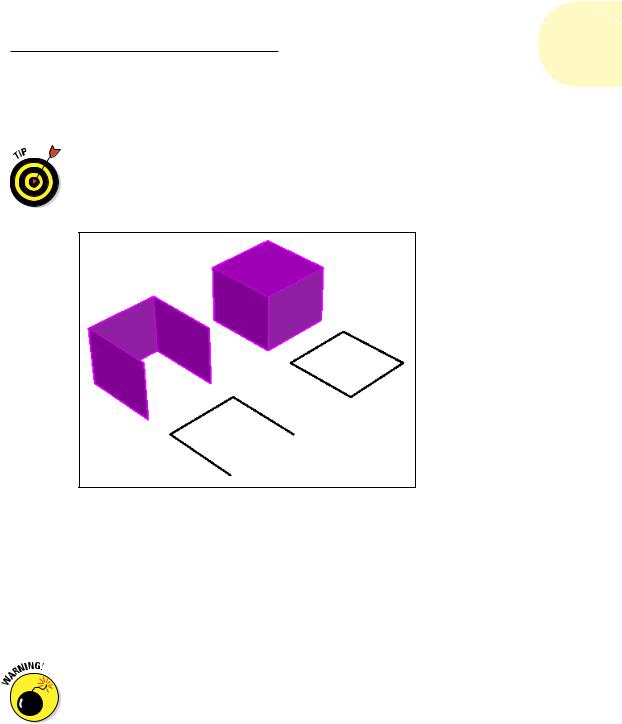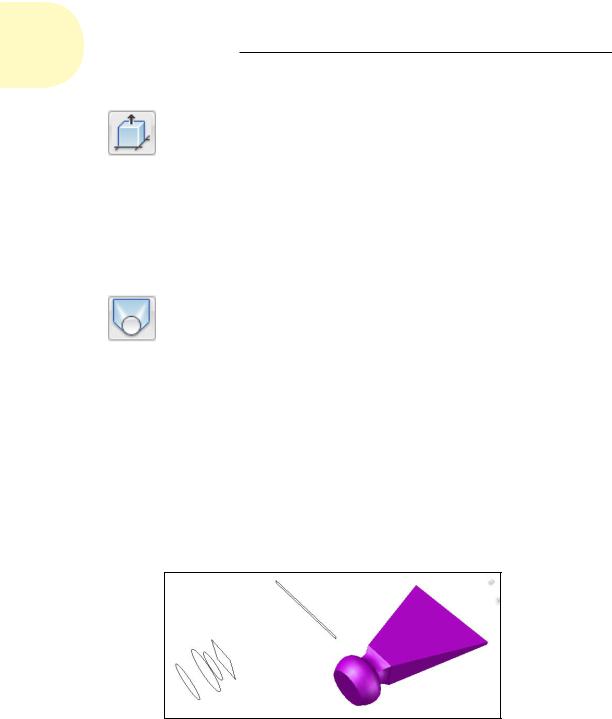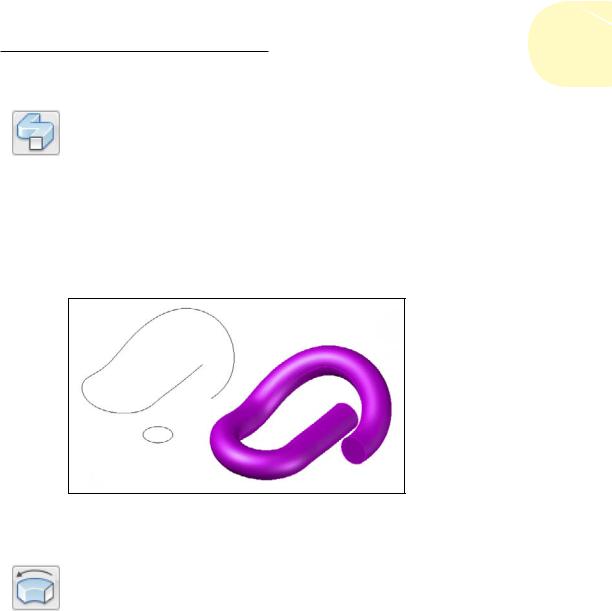
- •About the Authors
- •Dedication
- •Authors’ Acknowledgments
- •Table of Contents
- •Introduction
- •What’s Not (And What Is) in This Book
- •Mac attack!
- •Who Do We Think You Are?
- •How This Book Is Organized
- •Part I: AutoCAD 101
- •Part II: Let There Be Lines
- •Part III: If Drawings Could Talk
- •Part IV: Advancing with AutoCAD
- •Part V: On a 3D Spree
- •Part VI: The Part of Tens
- •But wait . . . there’s more!
- •Icons Used in This Book
- •A Few Conventions — Just in Case
- •Commanding from the keyboard
- •Tying things up with the Ribbon
- •Where to Go from Here
- •Why AutoCAD?
- •The Importance of Being DWG
- •Seeing the LT
- •Checking System Requirements
- •Suddenly, It’s 2013!
- •AutoCAD Does Windows (And Office)
- •And They’re Off: AutoCAD’s Opening Screens
- •Running with Ribbons
- •Getting with the Program
- •Looking for Mr. Status Bar
- •Let your fingers do the talking: The command window
- •The key(board) to AutoCAD success
- •Keeping tabs on palettes
- •Down the main stretch: The drawing area
- •Fun with F1
- •A Simple Setup
- •Drawing a (Base) Plate
- •Drawing rectangles on the right layers
- •Circling your plate
- •Nuts to you
- •Getting a Closer Look with Zoom and Pan
- •Modifying to Make It Merrier
- •Hip-hip-array!
- •Stretching out
- •Crossing your hatches
- •Following the Plot
- •A Setup Roadmap
- •Choosing your units
- •Weighing up your scales
- •Thinking annotatively
- •Thinking about paper
- •Defending your border
- •A Template for Success
- •Making the Most of Model Space
- •Setting your units
- •Making the drawing area snap-py (and grid-dy)
- •Setting linetype and dimension scales
- •Entering drawing properties
- •Making Templates Your Own
- •Setting Up a Layout in Paper Space
- •Will that be tabs or buttons?
- •View layouts Quick(View)ly
- •Creating a layout
- •Copying and changing layouts
- •Lost in paper space
- •Spaced out
- •A view(port) for drawing in
- •About Paper Space Layouts and Plotting
- •Managing Your Properties
- •Layer one on me!
- •Accumulating properties
- •Creating new layers
- •Manipulating layers
- •Using Named Objects
- •Using AutoCAD DesignCenter
- •Copying layers between drawings
- •Controlling Your Precision
- •Keyboard capers: Coordinate input
- •Understanding AutoCAD’s coordinate systems
- •Grab an object and make it snappy
- •Other Practical Precision Procedures
- •Introducing the AutoCAD Drawing Commands
- •The Straight and Narrow: Lines, Polylines, and Polygons
- •Toeing the line
- •Connecting the lines with polyline
- •Squaring off with rectangles
- •Choosing your sides with polygon
- •(Throwing) Curves
- •Going full circle
- •Arc-y-ology
- •Solar ellipses
- •Splines: The sketchy, sinuous curves
- •Donuts: The circles with a difference
- •Revision clouds on the horizon
- •Scoring Points
- •Commanding and Selecting
- •Command-first editing
- •Selection-first editing
- •Direct object manipulation
- •Choosing an editing style
- •Grab It
- •One-by-one selection
- •Selection boxes left and right
- •Perfecting Selecting
- •AutoCAD Groupies
- •Object Selection: Now You See It . . .
- •Get a Grip
- •About grips
- •A gripping example
- •Move it!
- •Copy, or a kinder, gentler Move
- •A warm-up stretch
- •Your AutoCAD Toolkit
- •The Big Three: Move, Copy, and Stretch
- •Base points and displacements
- •Move
- •Copy
- •Copy between drawings
- •Stretch
- •More Manipulations
- •Mirror
- •Rotate
- •Scale
- •Array
- •Offset
- •Slicing, Dicing, and Splicing
- •Trim and Extend
- •Break
- •Fillet and Chamfer and Blend
- •Join
- •When Editing Goes Bad
- •Zoom and Pan with Glass and Hand
- •The wheel deal
- •Navigating your drawing
- •Controlling your cube
- •Time to zoom
- •A View by Any Other Name . . .
- •Looking Around in Layout Land
- •Degenerating and Regenerating
- •Getting Ready to Write
- •Simply stylish text
- •Taking your text to new heights
- •One line or two?
- •Your text will be justified
- •Using the Same Old Line
- •Turning On Your Annotative Objects
- •Saying More in Multiline Text
- •Making it with Mtext
- •It slices; it dices . . .
- •Doing a number on your Mtext lists
- •Line up in columns — now!
- •Modifying Mtext
- •Gather Round the Tables
- •Tables have style, too
- •Creating and editing tables
- •Take Me to Your Leader
- •Electing a leader
- •Multi options for multileaders
- •How Do You Measure Up?
- •A Field Guide to Dimensions
- •The lazy drafter jumps over to the quick dimension commands
- •Dimension associativity
- •Where, oh where, do my dimensions go?
- •The Latest Styles in Dimensioning
- •Creating and managing dimension styles
- •Let’s get stylish!
- •Adjusting style settings
- •Size Matters
- •Details at other scales
- •Editing Dimensions
- •Editing dimension geometry
- •Editing dimension text
- •Controlling and editing dimension associativity
- •Batten Down the Hatches!
- •Don’t Count Your Hatches. . .
- •Size Matters!
- •We can do this the hard way. . .
- •. . . or we can do this the easy way
- •Annotative versus non-annotative
- •Pushing the Boundary (Of) Hatch
- •Your hatching has no style!
- •Hatch from scratch
- •Editing Hatch Objects
- •You Say Printing, We Say Plotting
- •The Plot Quickens
- •Plotting success in 16 steps
- •Get with the system
- •Configure it out
- •Preview one, two
- •Instead of fit, scale it
- •Plotting the Layout of the Land
- •Plotting Lineweights and Colors
- •Plotting with style
- •Plotting through thick and thin
- •Plotting in color
- •It’s a (Page) Setup!
- •Continuing the Plot Dialog
- •The Plot Sickens
- •Rocking with Blocks
- •Creating Block Definitions
- •Inserting Blocks
- •Attributes: Fill-in-the-Blank Blocks
- •Creating attribute definitions
- •Defining blocks that contain attribute definitions
- •Inserting blocks that contain attribute definitions
- •Edit attribute values
- •Extracting data
- •Exploding Blocks
- •Purging Unused Block Definitions
- •Arraying Associatively
- •Comparing the old and new ARRAY commands
- •Hip, hip, array!
- •Associatively editing
- •Going External
- •Becoming attached to your xrefs
- •Layer-palooza
- •Creating and editing an external reference file
- •Forging an xref path
- •Managing xrefs
- •Blocks, Xrefs, and Drawing Organization
- •Mastering the Raster
- •Attaching a raster image
- •Maintaining your image
- •Theme and Variations: Dynamic Blocks
- •Lights! Parameters!! Actions!!!
- •Manipulating dynamic blocks
- •Maintaining Design Intent
- •Defining terms
- •Forget about drawing with precision!
- •Constrain yourself
- •Understanding Geometric Constraints
- •Applying a little more constraint
- •AutoConstrain yourself!
- •Understanding Dimensional Constraints
- •Practice a little constraint
- •Making your drawing even smarter
- •Using the Parameters Manager
- •Dimensions or constraints — have it both ways!
- •The Internet and AutoCAD: An Overview
- •You send me
- •Send it with eTransmit
- •Rapid eTransmit
- •Bad reception?
- •Help from the Reference Manager
- •Design Web Format — Not Just for the Web
- •All about DWF and DWFx
- •Autodesk Design Review 2013
- •The Drawing Protection Racket
- •Autodesk Weather Forecast: Increasing Cloud
- •Working Solidly in the Cloud
- •Free AutoCAD!
- •Going once, going twice, going 123D
- •Your head planted firmly in the cloud
- •The pros
- •The cons
- •Cloudy with a shower of DWGs
- •AutoCAD 2013 cloud connectivity
- •Tomorrow’s Forecast
- •Understanding 3D Digital Models
- •Tools of the Trade
- •Warp speed ahead
- •Entering the third dimension
- •Untying the Ribbon and opening some palettes
- •Modeling from Above
- •Using 3D coordinate input
- •Using point filters
- •Object snaps and object snap tracking
- •Changing Planes
- •Displaying the UCS icon
- •Adjusting the UCS
- •Navigating the 3D Waters
- •Orbit à go-go
- •Taking a spin around the cube
- •Grabbing the SteeringWheels
- •Visualizing 3D Objects
- •Getting Your 3D Bearings
- •Creating a better 3D template
- •Seeing the world from new viewpoints
- •From Drawing to Modeling in 3D
- •Drawing basic 3D objects
- •Gaining a solid foundation
- •Drawing solid primitives
- •Adding the Third Dimension to 2D Objects
- •Creating 3D objects from 2D drawings
- •Modifying 3D Objects
- •Selecting subobjects
- •Working with gizmos
- •More 3D variants of 2D commands
- •Editing solids
- •Get the 2D Out of Here!
- •A different point of view
- •But wait! There’s more!
- •But wait! There’s less!
- •Do You See What I See?
- •Visualizing the Digital World
- •Adding Lighting
- •Default lighting
- •User-defined lights
- •Sunlight
- •Creating and Applying Materials
- •Defining a Background
- •Rendering a 3D Model
- •Autodesk Feedback Community
- •Autodesk Discussion Groups
- •Autodesk’s Own Bloggers
- •Autodesk University
- •The Autodesk Channel on YouTube
- •The World Wide (CAD) Web
- •Your Local ATC
- •Your Local User Group
- •AUGI
- •Books
- •Price
- •3D Abilities
- •Customization Options
- •Network Licensing
- •Express Tools
- •Parametrics
- •Standards Checking
- •Data Extraction
- •MLINE versus DLINE
- •Profiles
- •Reference Manager
- •And The Good News Is . . .
- •APERTURE
- •DIMASSOC
- •MENUBAR
- •MIRRTEXT
- •OSNAPZ
- •PICKBOX
- •REMEMBERFOLDERS
- •ROLLOVERTIPS
- •TOOLTIPS
- •VISRETAIN
- •And the Bonus Round
- •Index

504 Part V: On a 3D Spree
Primitive solids: The most basic of 3D building blocks, such as boxes, cones, and spheres. Primitive solids are based on simple geometric shapes, such as lines and circles.
Complex (or compound) solids: Made by combining primitive solids and optionally editing them with Boolean operations. The following sections focus on creating and modifying 3D solids.
Boolean editing operations (named for the Victorian English mathematician George Boole) use arithmetic-like functions to combine solid objects or remove parts of them. The three primary Boolean commands in AutoCAD are UNION, SUBTRACT, and INTERSECT. See “Boolean operations” later in this chapter for more information.
Adding the Third Dimension to 2D Objects
AutoCAD’s 2D roots run deep. Drafting continues to be the primary focus of the program, but recent AutoCAD releases have shifted focus, and the program has become more and more adept at 3D modeling. This section invites you to take what you probably have an abundance of right now (2D objects) and create new 3D objects from them.
Creating 3D objects from 2D drawings
You can create 3D objects from 2D objects by using a number of different techniques. You can add thickness or extrude an open 2D object to create a surface, or take multiple 2D cross sections and create a lofted object that
adapts to the shape and size of each cross section selected. Everything mentioned here applies to AutoCAD only (not AutoCAD LT), with the exception of the thickness property.
Add thickness to a 2D object
Most 2D objects, such as lines and circles, have a thickness property. Changing a 2D object’s thickness property does not create a true 3D object, but it does create a pseudo-surface that looks like a 3D surface. These pseudo-surfaces can hide objects beyond them, but they do have limitations. If you add thickness to a circle, an open cylinder is created without caps
on the top and bottom. If you change the thickness of a rectangle (which is really a polyline), you end up with four walls but no top or bottom.
Extrude open and closed objects
Thickness is one way of adding height to an object, but extruding an object is usually a better approach. You can extrude open or closed 2D objects to create a 3D object. Extruding a closed 2D object, such as a closed polyline,
www.it-ebooks.info

Chapter 22: From Drawings to Models 505
spline, ellipse, circle, or region, creates a 3D solid. Extruding an open 2D object, such as an open polyline, spline, line, or arc, creates a surface. Figure 22-8 shows results of extruding open and closed objects.
If you want to end up with a 3D solid, you must extrude a single, closed object, such as a circle or a closed polyline. If you want to produce a 3D solid from a boundary composed of multiple objects, read about PRESSPULL later in this chapter.
Figure 22-8: 2D to 3D by extrusion is easy as 1, 2, 3.
To extrude an open or a closed 2D object, click Extrude on the Solid panel of the Solid tab, or click the Extrude split button on the Home tab’s Modeling panel. If you see a button labeled Loft, Revolve, or Sweep, click the lower part of the split button and choose Extrude from the drop-down menu. Use the MOde option to control whether you create a surface or 3D solid from a closed object, select the objects you want to extrude, and specify an extrusion height or distance to create the 3D solid.
The DELOBJ system variable controls whether the 2D objects you use to create 3D solids are retained or erased. Most of the time, you probably want to keep the source geometry, but the default DELOBJ setting erases it. If you want to keep the original 2D geometry, type DELOBJ and set its value to 0. (See Chapter 26 for more about system variables.) DELOBJ also controls whether or not the source objects for associative arrays (introduced in Chapter 18) are retained or deleted.
www.it-ebooks.info

506 Part V: On a 3D Spree
Press and pull closed boundaries
The PRESSPULL command allows you to create 3D geometry by extruding a closed boundary. PRESSPULL differs from EXTRUDE in that the EXTRUDE command requires a single, closed 2D object while PRESSPULL can use closed boundaries formed by other 3D solids, or by several objects that form a closed region. PRESSPULL searches for a suitable boundary in exactly the same manner as the HATCH command, which we cover in Chapter 15.
To press or pull within a closed boundary to create a 3D object, click Presspull on the Solid tab’s Solid panel, click inside an enclosed boundary, and then drag or specify the distance on the extrusion you want to create.
Loft open and closed objects
Lofting allows you to select a series of 2D cross sections to create a surface or 3D solid. The selected cross sections are used to define the outer surface that’s generated. You must select a minimum of two cross sections. If you select open objects, the resulting loft is a surface; if you select closed objects, the resulting loft can be either a surface or 3D solid, depending on the current value of the MOde option for the LOFT command.
You can loft objects along a path by using guide curves, or just between the selected cross sections (see Figure 22-9). To loft open or closed 2D objects, open the Sweep/Loft drop-down on the Solid tab’s Solid panel. Use the MOde option to control whether you create a surface or 3D solid from a closed object cross section, and specify how the loft object should be calculated.
The term “loft” derives from the days of wooden sailing ships. The shipyards had an upstairs area, much like the hayloft in a barn, where they determined the shape of each plank that was required to form the curves of the hull.
Because it was performed in the loft, the process became known as “lofting.”
Figure 22-9: Using cross sections to create a lofted object.
www.it-ebooks.info

Chapter 22: From Drawings to Models 507
Sweep open and closed objects along a path
Sweeping is similar to extruding a 2D object except that you specify a path, rather than a height or distance. The object used as the path can be either an open or closed 2D object, and can be only a single object (see Figure 22-10). If you sweep an open object, the resulting swept object is a surface; if you sweep a closed object, the resulting swept object is a surface or 3D solid based on the current value of the MOde option of the SWEEP command.
To sweep an open or closed 2D object, open the Sweep/Loft drop-down on the Solid panel of the Solid tab. Use the MOde option to control whether you create a surface or 3D solid from a closed object, select the objects to sweep, and specify a path for the sweep.
Figure 22-10: Sweeping a closed object along a path.
Revolve open or closed objects around an axis
Revolving allows you to create a surface or 3D solid by turning selected objects around an axis (see Figure 22-11). If open objects are selected, the resulting revolved object is a surface; if you select closed objects, the resulting revolved object is a 3D solid.
To revolve an open or a closed 2D object, click Revolve on the Solid panel of the Solid tab, or click the Revolve split button on the Home tab’s Modeling panel. (If you see a button labeled Loft, Extrude, or Sweep, click the lower part of the split button and choose Revolve from the drop-down list. Use the MOde option to control whether you create a surface or 3D solid from a closed object, select the objects to revolve, and specify the axis to use.
www.it-ebooks.info
